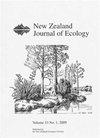Good predators: the roles of weka (Gallirallus australis) in New Zealand’s past and present ecosystems
IF 1.4
3区 环境科学与生态学
Q3 ECOLOGY
引用次数: 10
Abstract
There is increasing interest in restoring native predators in order to regulate ecosystems and maintain biodiversity, but predator reintroductions are still controversial for complex social and ecological reasons. Few studies have examined predator restoration on islands or in ecosanctuaries, where highly endemic faunas have typically undergone precipitous declines and extinctions due to novel invasive predators, and translocations are used to restore species. Currently in New Zealand, discussions regarding predators typically focus on introduced mammalian pests, and the importance of native predators is frequently overlooked. We present a case study of the mesopredatory New Zealand weka (Gallirallus australis), a threatened flightless rail that provokes controversy among restoration practitioners due to concerns that it may decrease populations of other threatened species. We (1) review studies of weka diet and impacts on native and exotic fauna; (2) contrast prehistoric and contemporary predation webs focused on weka; and (3) consider the role of biocultural approaches in the management and restoration of socio-ecological systems with weka. Weka are opportunistic omnivores that can include vertebrates in their diet, and on small islands where weka can reach high densities there is some evidence that they may limit some prey populations. However, very few manipulative experimental studies measuring effects of weka on native species have been carried out, and such studies would be extremely valuable. Weka also consume invasive rodents and, if they obtain a sufficiently high density, may provide benefits in ecosanctuaries by limiting invasive mice populations. Māori historically harvested weka, and such harvest may now valuably limit weka numbers at certain island or ecosanctuary sites, perhaps replacing the effect of extinct avian competitors and apex predators. How weka and other native predators should be managed on islands depends on the value placed on ecosystem restoration, species-focused conservation, or biocultural enrichment.好的捕食者:在新西兰过去和现在的生态系统中weka (Gallirallus australis)的角色
为了调节生态系统和维持生物多样性,人们对恢复本地捕食者的兴趣越来越大,但由于复杂的社会和生态原因,捕食者的重新引入仍然存在争议。很少有研究对岛屿或生态保护区的捕食者恢复进行了调查,在这些地方,由于新的入侵捕食者,高度地方性的动物群通常经历了急剧下降和灭绝,并且采用了易位来恢复物种。目前在新西兰,关于捕食者的讨论通常集中在引进的哺乳动物害虫上,而本土捕食者的重要性经常被忽视。我们提出了一个关于中游新西兰weka (Gallirallus australis)的案例研究,这是一种受威胁的不会飞的铁轨,由于担心它可能会减少其他受威胁物种的数量,因此在恢复从业者中引起了争议。我们(1)综述了weka的饮食及其对本地和外来动物群的影响;(2)对比史前和现代以weka为中心的捕食网;(3)考虑生物文化方法在weka社会生态系统管理和恢复中的作用。威卡是机会主义杂食动物,它们的饮食中包括脊椎动物,在威卡可以达到高密度的小岛上,有证据表明它们可能会限制一些猎物的数量。然而,目前很少有测量weka对本地物种影响的可操作实验研究,这些研究将是非常有价值的。Weka也消耗入侵的啮齿动物,如果它们获得足够高的密度,可以通过限制入侵的老鼠数量来为生态保护区提供好处。Māori历史上曾收获过维卡鸟,这种收获现在可能在某些岛屿或生态保护区有价值地限制了维卡鸟的数量,可能取代了灭绝的鸟类竞争对手和顶级捕食者的影响。如何管理岛上的weka和其他本地食肉动物取决于生态系统恢复、物种保护或生物文化丰富的价值。
本文章由计算机程序翻译,如有差异,请以英文原文为准。
求助全文
约1分钟内获得全文
求助全文
来源期刊

New Zealand Journal of Ecology
环境科学-生态学
CiteScore
3.00
自引率
12.50%
发文量
35
审稿时长
>36 weeks
期刊介绍:
The New Zealand Journal of Ecology is a biannual peer-reviewed journal publishing ecological research relevant to New Zealand/Aotearoa and the South Pacific. It has been published since 1952 (as a 1952 issue of New Zealand Science Review and as the Proceedings of the New Zealand Ecological Society until 1977). The Journal is published by the New Zealand Ecological Society (Inc.), and is covered by Current Contents/Agriculture, Biology and Environmental Science, GEOBASE, and Geo Abstracts.
 求助内容:
求助内容: 应助结果提醒方式:
应助结果提醒方式:


